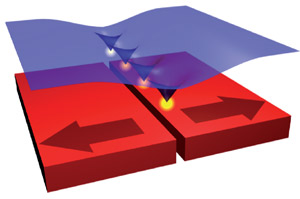Jan. 14, 2011 Research Highlight Physics / Astronomy
Particles that are their own worst enemies
A newly proposed superconducting device could lead to the first observation of particles that are their own antiparticles
 Figure 1: A schematic diagram of Majorana particles lined up in two opposing magnetic fields (red) that interact with a superconducting topological insulator (blue). At the gap between the magnets, the superconductor is weakened and magnetic field lines assemble in a periodic chain to which Majorana particles (yellow) attach. Reproduced, with permission, from Ref. 1 © 2010 The American Physical Society
Figure 1: A schematic diagram of Majorana particles lined up in two opposing magnetic fields (red) that interact with a superconducting topological insulator (blue). At the gap between the magnets, the superconductor is weakened and magnetic field lines assemble in a periodic chain to which Majorana particles (yellow) attach. Reproduced, with permission, from Ref. 1 © 2010 The American Physical Society
The matter that makes up the universe consists of particles such as electrons and protons, as well as their counterparts known as antiparticles. Particles and antiparticles that collide, however, annihilate each other in an intense flash of energy. Nevertheless, the Italian physicist Ettore Majorana proposed that some particles could exist that are their own antiparticles although physicists are yet to observe such particles.
Researchers from the RIKEN Advanced Science Institute in Wako have now proposed a scheme where Majorana particles could be not only observed for the first time but also manipulated1. The observation would occur in a conventional material rather than space. “Our main aim is to find a platform where the existence of Majorana fermions can be shown,” explains team member Shigeki Onoda. “And beyond that, we propose concrete steps towards the control of several Majorana particles.”
In some rare materials, energetic excitations that resemble Majorana particles are predicted to exist in materials. One class of these materials is known as topological insulators on the surface of which electrons can travel almost unperturbed. In topological insulators that are also superconducting, Majorana particles are predicted to exist in the presence of magnetic fields. These Majorana particles can be imagined as electronic excitations that run around the magnetic field lines.
The device proposed by Onoda and his colleagues offers deliberate control over Majorana particles within a topological insulator that they hope will make them accessible to experiments. Their device consists of a surface of a superconducting topological insulator attached to two magnetic sections (Fig. 1). The magnetic fields of the two magnets point in opposite directions. The researchers predict that, along the interface between the magnets, a periodic chain of magnetic field lines form in the superconducting topological insulator. Each of these magnetic field lines could accommodate a Majorana particle.
Once their existence is proved, Majorana particles could also enable extremely stable new forms of computing based on quantum physics, says Onoda. “As long as the Majorana particles are well separated, the information encoded in these states would be robust against local perturbations.”
For the time being, however, such quantum computing schemes must remain theoretical. Although widely expected to exist, superconducting topological insulators, as yet, exist only in theory. Once such a material has been found, the researchers believe that the proposed device structure will be straightforward to implement. The expected periodic arrangement of Majorana particles would then provide a convenient platform to study these elusive particles.
References
- 1. Neupert, T., Onoda, S. & Furusaki, A. Chain of Majorana states from superconducting Dirac fermions at a magnetic domain wall. Physical Review Letters 105, 206404 (2010). doi: 10.1103/PhysRevLett.105.206404
